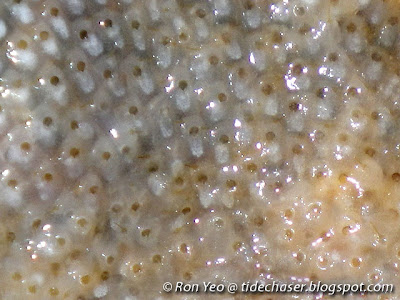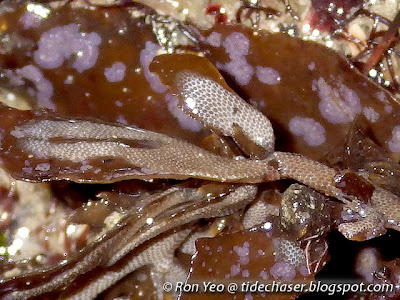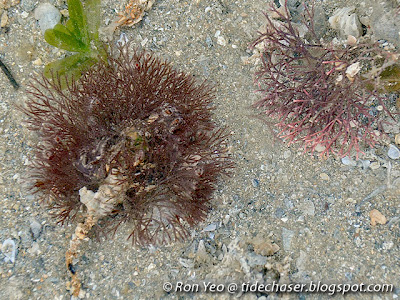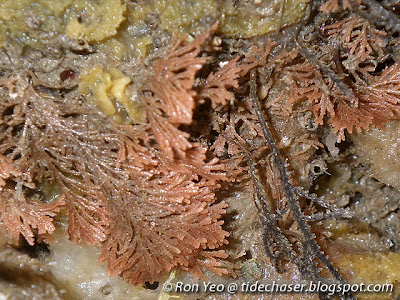Bryozoans (phylum Bryozoa) are tiny organisms that mostly live in colonies (except for one solitary species). They are sometimes called moss animals due to the plant-like appearances of many species. In fact, the name "bryozoa" comes from the Greek words "bryon" for moss and "zoon" for animal. The individual bryozoan animal is called a zooid, and it usually lives in a "chamber" called a zooecium, which is basically a protective chitinous or calcareous exoskeleton. The zooecium has an opening (called an orifice), through which the zooid will extend its lophophore, which is essentially a retractable horseshoe-shaped or circular crown of tentacles for filtering plankton and other tiny food particles from the water. Some species may have an operculum covering the orifice.
There are various types of bryozoan zooids, but all colonies will have autozooids, which are responsible for feeding and excretion. Depending on the species, some colonies may have specialised zooids for brooding eggs or for defense purposes.
Most bryozoans are hermaphroditic, meaning they have both male and female reproductive parts. Some species are simultaneous hermaphrodites with both male and female reproductive parts at the same time. Others are sequential hermaphrodites, starting off as males first before becoming females. In species with separate sexes (or dioecious), the colony may be made up of only zooids of the same sex, or both sexes may present. To reproduce sexually, the sperm will be release into the water. For the eggs, some species also release them into the water, while others will capture the sperm using their tentacles to fertilise their eggs and brood them internally. The eggs will eventually develop into free-swimming larvae, which will settle down on suitable substrates and metamorphose into a zooid. The first zooid of a colony is called the ancestrula, and it will reproduce asexually by budding off new zooids to form a colony.
Depending on the species, the bryozoan colonies may be encrusting, plant-like or lace-like. As such, they are often confused with other similar-looking organisms, such as encrusting sponges, encrusting tunicates, hydroids, algae, and leafy corals. It is sometimes possible to differentiate them by looking closely at the surface of the colony, though this may not always be reliable for plant-like species.
I do not personally know anyone who studies the byrozoans in local waters, and hence most of the byrozoans that I have seen are not yet identified. If you are able to identify them or spot any mistakes below, do let me know!
Encrusting Bryozoans
The most commonly seen bryzoans are probably the encrusting ones - they can be easily found under rocks and coral rubble, on pillars of jetties and coastal structures, and even on living organisms such as snail shells, seaweed and seagrass!

Encrusting bryozoans may superficially resemble encrusting sponges and tunicates, but they usually feel hard when you touch them, unlike sponges and tunicates which usually feel a little soft and rubbery.

A closer examination will reveal cell-like patterns, which are the zooecia (or exoskeleton) of the individual zooids.

This dark brown, encrusting bryozoan has zooecia radiating out from the centre of the colony, forming obvious patterns.

The orifices of this translucent white bryozoan appear like small black dots scattered over the surface of the colony.

A closer look at the colony reveals the zooids within the translucent zooecia.

Encrusting bryozoans can be found on living things too. This white encrusting bryozoan, probably a Membranipora sp., can be commonly found appearing as small white patches on the fronds of marine algae, such as the sargassum seaweed featured in the above picture.

The above picture features a Membranipora sp. growing on the fronds of some seagrass leaf blades.
Lace-like Bryozoans
Most of the lace-like bryozoans that I have seen in local waters attach themselves to sea fans, hydroids and sometimes branching sponges. Compared to the encrusting species, they are easier to identify with their lace-like or ribbon-like appearance, though some may be confused with encrusting tunicates. Lace-like bryozoans are usually from the family Phidoloporidae.

This lace-like bryozoan has numerous holes on the colony, giving it a net-like appearance.

A closer look reveals numerous small dark spots, which are the orifices of the zooecia.

This lace-like bryozoan may appear similar to the previous one from afar, but it lacks the numerous holes.

The zooecia appear somewhat rectangular when you look closely.
Plant-like Bryozoans
Plant-like bryozoans have branching colonies, and are often confused with algae and hydroids. Some species may be very difficult to differentiate from hydroids as the zooecia and orifices may not be obvious.

This branching bryozoan (left) is easily mistaken to be a red branching coralline algae (right), and even more so as they may occur in the same area.

Examine it closely, and you will notice that the "stem" appears to be made up of many segments, which are actually the zooecia.

This orange branching bryozoan is also often mistaken to be a hydroid.

The orifices can be seen when you examine the colony more closely as well.

The above bryozoan is found growing on a piece of log on a mudflat. It exhibits a root-like growth-form spreading on the log surface, instead of standing erect.
References
There are various types of bryozoan zooids, but all colonies will have autozooids, which are responsible for feeding and excretion. Depending on the species, some colonies may have specialised zooids for brooding eggs or for defense purposes.
Most bryozoans are hermaphroditic, meaning they have both male and female reproductive parts. Some species are simultaneous hermaphrodites with both male and female reproductive parts at the same time. Others are sequential hermaphrodites, starting off as males first before becoming females. In species with separate sexes (or dioecious), the colony may be made up of only zooids of the same sex, or both sexes may present. To reproduce sexually, the sperm will be release into the water. For the eggs, some species also release them into the water, while others will capture the sperm using their tentacles to fertilise their eggs and brood them internally. The eggs will eventually develop into free-swimming larvae, which will settle down on suitable substrates and metamorphose into a zooid. The first zooid of a colony is called the ancestrula, and it will reproduce asexually by budding off new zooids to form a colony.
Depending on the species, the bryozoan colonies may be encrusting, plant-like or lace-like. As such, they are often confused with other similar-looking organisms, such as encrusting sponges, encrusting tunicates, hydroids, algae, and leafy corals. It is sometimes possible to differentiate them by looking closely at the surface of the colony, though this may not always be reliable for plant-like species.
I do not personally know anyone who studies the byrozoans in local waters, and hence most of the byrozoans that I have seen are not yet identified. If you are able to identify them or spot any mistakes below, do let me know!
Encrusting Bryozoans
The most commonly seen bryzoans are probably the encrusting ones - they can be easily found under rocks and coral rubble, on pillars of jetties and coastal structures, and even on living organisms such as snail shells, seaweed and seagrass!

Encrusting bryozoans may superficially resemble encrusting sponges and tunicates, but they usually feel hard when you touch them, unlike sponges and tunicates which usually feel a little soft and rubbery.

A closer examination will reveal cell-like patterns, which are the zooecia (or exoskeleton) of the individual zooids.

This dark brown, encrusting bryozoan has zooecia radiating out from the centre of the colony, forming obvious patterns.

The orifices of this translucent white bryozoan appear like small black dots scattered over the surface of the colony.

A closer look at the colony reveals the zooids within the translucent zooecia.

Encrusting bryozoans can be found on living things too. This white encrusting bryozoan, probably a Membranipora sp., can be commonly found appearing as small white patches on the fronds of marine algae, such as the sargassum seaweed featured in the above picture.

The above picture features a Membranipora sp. growing on the fronds of some seagrass leaf blades.
Lace-like Bryozoans
Most of the lace-like bryozoans that I have seen in local waters attach themselves to sea fans, hydroids and sometimes branching sponges. Compared to the encrusting species, they are easier to identify with their lace-like or ribbon-like appearance, though some may be confused with encrusting tunicates. Lace-like bryozoans are usually from the family Phidoloporidae.

This lace-like bryozoan has numerous holes on the colony, giving it a net-like appearance.

A closer look reveals numerous small dark spots, which are the orifices of the zooecia.

This lace-like bryozoan may appear similar to the previous one from afar, but it lacks the numerous holes.

The zooecia appear somewhat rectangular when you look closely.
Plant-like Bryozoans
Plant-like bryozoans have branching colonies, and are often confused with algae and hydroids. Some species may be very difficult to differentiate from hydroids as the zooecia and orifices may not be obvious.

This branching bryozoan (left) is easily mistaken to be a red branching coralline algae (right), and even more so as they may occur in the same area.

Examine it closely, and you will notice that the "stem" appears to be made up of many segments, which are actually the zooecia.

This orange branching bryozoan is also often mistaken to be a hydroid.

The orifices can be seen when you examine the colony more closely as well.

The above bryozoan is found growing on a piece of log on a mudflat. It exhibits a root-like growth-form spreading on the log surface, instead of standing erect.
References
- Allen, G. & R. Steene. 1999. Indo-Pacific Coral Reef Field Guide. Singapore. Tropical Reef Research. 378 pp.
- Bock, P. 2012. Recent and Fossil Bryozoa. Retrieved Jan 30, 2013, from http://www.bryozoa.net.
- Branch, M. L., C. I. Griffiths & L. E. Beckley. 2007. Bryozoa: Moss or Lace Animals. Two Oceans - A Guide to the Marine Life of Southern Africa. Struik. pp. 104–110.
- Chou, L. M. 1998. A Guide to the Coral Reef Life of Singapore. Singapore Science Centre. 128 pp.
- Introduction to the Bryozoans. Smithsonian Marine Station at Fort Pierce. Retrieved Jan 30, 2013, from http://www.sms.si.edu/irlspec/IntroBryozoa.htm.
- Ruppert, E.E. and R.D. Barnes. 1991. Invertebrate Zoology (International Edition). Saunders College Publishing. U.S.A. 1056 pp.
- World Register of Marine Species. 2012. Retrieved Jan 30, 2013, from http://www.marinespecies.org.

No comments:
Post a Comment